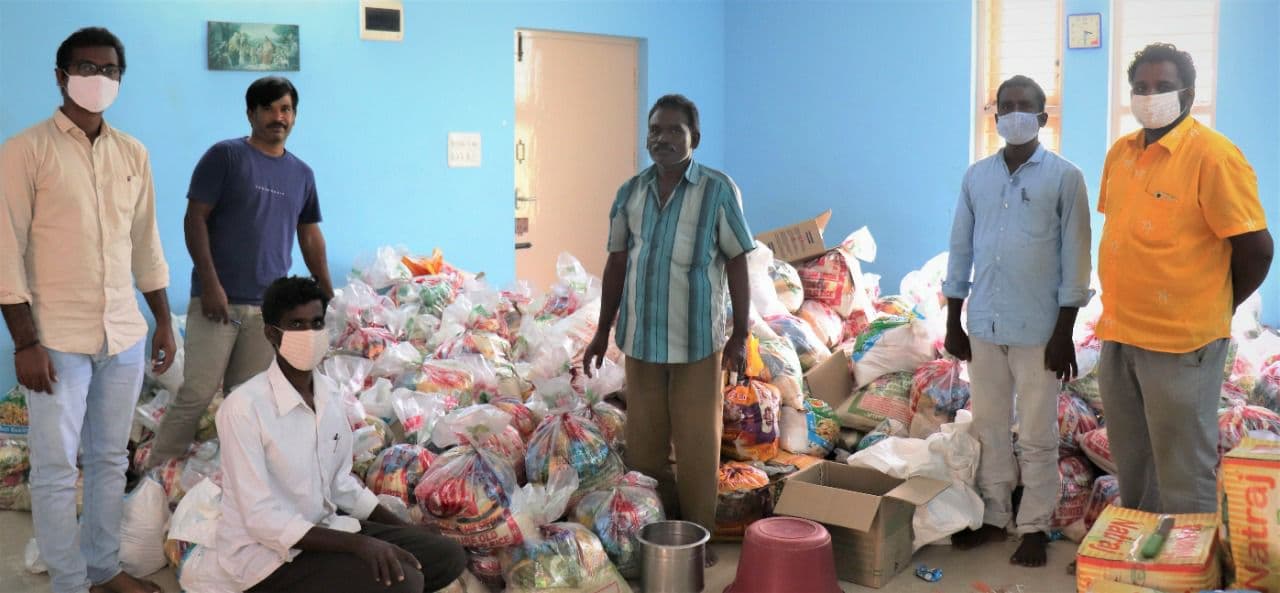
OUR RESPONSE TO COVID-19
SUMMARY OF SURVEY FINDINGS
In the first staff meeting during the Pandemic, the hardships of families without ration card to access food grains from the Public Distribution System (PDP) was highlighted. According to our staff, this had resulted in hunger and starvation in many families and some of them had even started to beg. We immediately decided to help such families by providing ‘Provision Kit’ and financial assistance. Side by side, we also initiated a survey to (a). understand better the families we care for and (b). to ascertain how many of them lacked the essential documents to benefit from various Government Welfare Programmes. This was with the intention of helping those lacking essential documents to apply for the same.
In Palamaner[1], the survey was conducted primarily in hamlets (a). where ‘Study Centre’ and ‘Educational Assistance’ Programmes are implemented, and (b). adjoining hamlets affected by the pandemic. A total of 36 hamlets were covered by the survey comprising 1933 families and 7188 family members. Families of children studying in Kinder Care Special School were considered as one unit for the survey.
Major Findings
With Regard to Respondents and their Families
The survey findings confirm the generally held belief that CSA Trust works with the most disadvantaged and is a clear indication that its preferential option for the poor and the marginalised is fully realised through its actions at the grassroot level. As per the findings, the current outreach is 17% tribal, 73% scheduled caste, 8% backward caste and 2% of other castes. We are fully satisfied that the ‘Provision Kit’ distribution programme has benefited those who needed it the most. In the caste hierarchy of Andhra Pradesh, Yanadhis (ST), Madigas (SC), and Malas (SC) belong to the bottom strata of the population. It is therefore accurate to state that 90% of our beneficiaries are socially disadvantaged and economically deprived. Of the remaining 10%, 8% is economically and socially backward. Only 2% of the respondents are socially forward. However, their economic deprivation is the major reason why they are part of our enabling process.
- Family Constitution: The respondents are more or less equally divided between female (50.4%) and male (49.6%). However, we are unsure of the implications of a smaller percentage of daughters (17%) compared to sons (24%) in respondent families.
- Life expectancy among the respondent population is very low with only 5% being in the 60-69 age bracket and a meagre 3% who are 70 years and above. Compare these figures to life expectancy in India which is 69 years (women 70.4 years and men 67.8 years) for a better understanding of the gravity of the situation.
- Forty-two percent of the respondents are illiterate. About 13% of children who are of school going age are not in school. Only 7% have completed their intermediate or vocational training. The percentage of graduates among the respondent population is 5%. The high percentage of illiterate respondents (42%) and those having studied up to high school (13%) is a reflection of poor educational facilities at the grassroots level. Of some satisfaction to CSA Trust is the fact that 55% of children in school are beneficiaries of the ‘Educational Assistance’ and ‘Study Centre Programmes. The number of children helped under the above programmes in participating hamlets in 2019-20 was 1008.
- Education among ST Families: The educational standards among Scheduled Tribe families are still worse. About 39% of children who are in the school going age are not in school. Sixty one percent of the population is illiterate. A meagre 1.3% have completed their intermediate studies and only 0.3% (4) their graduation. The literacy rate of India at present is 77.7% and that of Andhra Pradesh, 66.4%. However, when it comes to Scheduled Tribe Population in our working hamlets, it is only 39%.
Major Findings
With regard to Essential Documents
A year ago, the Andhra Pradesh Government introduced a special scheme (Amma Vodi) to help poor families with school going children. A sum of Rs. 15,000/- was given as a contribution to poorer families towards the education of their children. To be eligible, students had to have their a). Aadhar Card and, b). Family Ration Card with the students’ name on it. Families with school going children worked over-time with Teachers and Government Officials to get these documents ready with a high success rate.
Aadhar Card
Aadhar Card generally permits the holder to avail of government subsidies they are eligible for. The card can also be used as proof of identity and proof of address. Of the 7188 respondents, 96% have Aadhar cards. In the case of the remaining 4% (266), there are mistakes in the card already issued (60), or have applied but yet to receive the card (25). The remaining 181 respondents have yet to apply for the card.
Though not legally binding and essential, Aadhar Card has become an essential document for all Indians. Nothing actually works at the grassroots without Aadhar Card.
Ration Card
Ration card is essential to procure food grains free or at subsidised rates from the Public Distribution System (PDS). The food grains supplied by PDS becomes crucial for survival during lock down/pandemic. Most people have no or limited employment and thus no ready cash to purchase provisions in the open market. Ration card is therefore as good as one’s survival kit. Each family has a card and food grains are as per number of members in the family. Currently 89% of the families have ration cards. Of the remaining 11%, 2% (141) of the cases need the respondent name to be included in the card, 3% (197) have applied for inclusion of their names and the remaining 6% (443 families) do not have ration card.
Aarogyasri (Health) Card
For the poor and the disadvantaged, Aarogyasri card is their passport to free treatment at times of ill health, accident, etc. The benefit is generally provided in Government hospitals without much fuss. However, it is more difficult to access benefits from many of the Private hospitals even with the card. As can be observed, only 87% of the respondents have the health card. There is another 2% (117) who have applied but yet to receive the card. The remaining 11% (803) do not have the card.
MGNREGA (JOB) Card
We are looking into the reason why relatively lower percentage (56%) of eligible adults are registered under the rural employment scheme. As per data, 4901 of the respondents (18+ age group) are eligible for registration but only 2717 have registered so far. The relative low percent of registration under MGNREGA could be due to many from the hamlets being migrant labourers, cumbersome process in registration, etc.
Birth Certificate
Birth Certificate is required to prove one’s age and is essential for school admissions, application for essential document, etc. It is shocking therefore that 88% of the respondents do not have their birth certificates. This is too high a percentage to be ignored. It might be possible to help younger respondents apply for their birth certificate. However, the procedure is cumbersome, time consuming and there are expenses involved.
Documents – Scheduled Tribe Families
The Yanadi’s found in the vicinity of Palamaner are some of the most poor and neglected people living in this region. Seventeen percent (1197) of respondents of the survey belong to this group. We are therefore happy to highlight findings of the study in relation to availability of documents with them.
- Aadhar Card: One hundred and eleven (9%) respondents do not either have the Aadhar card or the card they have is faulty; thus, not eligible for government subsidies or welfare programme benefits.
- Ration Card: Fourteen percent (167) of the families do not have a ration card. A smaller number of respondents (42) have to have their names included in the family ration card or are yet to receive it (35) though they have applied for the same. In essence, 20% (244) of the respondents do not benefit from the Public Distribution System at the time of the survey.
- Aarogyasri (Health) Card: Twenty four percent (291) family members are not enrolled for the health scheme. Another 3% (35) have applied for it but not yet issued the card. Thus, a total of 27% cannot avail benefits under the health programme. As already pointed out, those not enrolled are not eligible for any free or subsidised medical treatment.
- MGNREGA Registration: The percentage of persons above 18 not registered under ‘the right to work’ programme is 40% (475). Another 3 persons have applied, but not yet received the Card. Non registration under the rural employment scheme deprives each member of guaranteed labour and minimum wages of Rs. 202/- per day for a minimum 100 days a year. The key tenet of this law is guaranteed 100 days of wage employment in rural India to enhance quality of life. However, with 40% eligible persons not registered for the programme, benefits accruing to the needy is limited.
- Birth Certificate: The basic document that is required to be submitted for the issue of the above cards (Aadhar, Ration, Health and Employment) is one’s Birth Certificate. Currently only 116 (10%) of the ST respondents have their Birth Certificate. Birth Certificate is difficult to acquire but is an essential document one should possess. In most instances, it costs money and many days of efforts to get the Certificate.
Conclusion
The following are some of the conclusions that can be arrived at out of the survey and interactions with our staff.
- The vulnerability of the poorest have gone up during the Pandemic. There is starvation in many families and growing indebtedness in the local grocery shop, to landlords and money lenders.
- A sizeable percentage of the rural poor do not have the essential documents (Aadhar, Ration, Health and Employment card and Birth Certificate) required to benefit from Government Welfare Programmes.
- What should be of concern is that those who do not have the necessary cards/documents are the poorest in the caste/class ladder, viz. Scheduled Tribe and Scheduled Caste families. They actually stand to benefit the most from government subsidies and welfare schemes but cannot benefit as they lack the necessary documents.
- Due to the ‘Amma Vodi’ scheme of the Government, most families having school going children have made their Aadhar and Ration Card last year incurring considerable expenses. A similar drive would be essential to register for Health Card, MGNREGA card and Birth Certificate.
- There is need from the part of various government officials and departments to walk the extra mile to enable the poorest have the essential documents; their passport to identity, food, health care, employment and self-actualisation.
- Our staff at Palamaner is now in touch with various agencies/departments to help persons avail documents that are essential to avail government benefits. However, this is a time consuming and tedious process with limited success. The Government should make this process much easier and flexible for those who need it the most.
- The tribal families require immediate attention – to address issues of starvation, to have necessary cards to benefit from the various welfare programmes of the State and to have their children in school
Palamaner
31 October 2020
[1] Palamaner, Chittoor District, Andhra Pradesh
